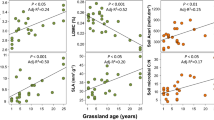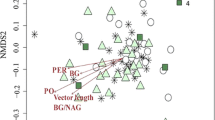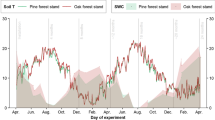Abstract
The soil nutrients, microbes, and arthropods of tropical forests are patchy at multiple scales. We asked how these three factors interact to generate patterns of decomposition in 450 100 cm2 litterbags arrayed along a 50 m ridge top in a Panama rainforest. We tested top-down (via grazing by microbivores like collembola and diplopods) and bottom-up (via added N and P) effects on the decomposition of cellulose. By using a 1,000-fold gradient in mesh size we generated a two-fold gradient in arthropod grazing. Microbivore grazing first retarded then ultimately enhanced decomposition rates. Micropulses of N and P (simulating concentrated urine) enhanced neither decomposition rates nor microbivores but increased the abundance of predacious ants. Decomposition rates also varied across the ridge, and were lowest in a plot with the deepest litter and highest soil moisture. These data generate the working hypothesis that N and P cascade upward at grains of 100 cm2 to enhance a major predator in the litter; predators then absorb any increases in microbivores attracted to the extra fungal growth. These population interactions are in turn embedded in mesoscale variability generated by individual tree canopies that drive changes in litter quality and soil moisture.


Similar content being viewed by others
References
Aerts R (1997) Climate leaf litter chemistry and leaf litter decomposition in terrestrial ecosystems: a triangular relationship. Oikos 79:439–449
Allen AP, Gillooly JF, Brown JH (2005) Linking the global carbon cycle to individual metabolism. Funct Ecol 19:202–213
Beare MH, Constance L Neely, Coleman DC, Hargrove WL (1990) A substrate-induced respiration (SIR) method for measurement of fungal and bacterial biomass on plant residues. Soil Biol Biochem 22:585–594
Binkley D (1986) Forest nutrition management. Wiley, New York
Blair JM, Crossley DA, Rider S (1989) Effects of naphthalene on microbial activity and nitrogen pools in soil-litter microcosms. Soil Biol Biochem 21:507–510
Bohlman S, O’Brien S (2006) Allometry, adult stature and regeneration requirement of 65 tree species on Barro Colorado Island. J Trop Ecol 22:123–136
Byrne M, Levey D (1993) Removal of seeds from frugivore defecations by ants in a Costa Rican forest. Vegetatio 107/108:363–374
Cadisch G, Giller KE (eds) (1997) Driven by nature: plant litter quality and decomposition. CAB International, Wallingford, UK
Cebrian J, Lartigue J (2004) Patterns of herbivory and decomposition in aquatic and terrestrial ecosystems. Ecology 74:237–259
Chen B, Wise D (1999) Bottom-up limitation of predaceous arthropods in a detritus-based terrestrial food web. Ecology 80:761–772
Coley PD, Barone JA (1996) Herbivory and plant defenses in tropical forests. Annu Rev Ecol Syst 27:305–335
Crossley DAJ (1977) The roles of terrestrial saprophagous arthropods in forest soils: current status of concepts. In: Mattson (ed) The role of arthropods in forest ecosystems. Springer, New York, pp 49–56
Dix NJ, Webster J (1995) Fungal ecology. Chapman and Hall, Oxford
Dowding P (1976) Allocation of resources, nutrient uptake and release by decomposer organisms. In: Anderson JM, Macfayden A (eds) The role of terrestrial and aquatic organisms in decomposition processes. Blackwell, Oxford, UK, pp 169–184
Edwards CS, Heath G (1963) The role of soil animals in breakdown of leaf material. In: Doeksen J, Van der Drift J (eds) Soil organisms. North Holland, Amsterdam, pp 76–84
Enriquez S, Duarte C, Sand-Jensen K (1993) Patterns in decomposition rates among photosynthetic organisms: the importance of detritus C:N:P content. Oecologia 94:457–471
Ettema CH, Coleman DC, Vellidis G, Lowrance R, Rathbun SL (1998) Spatiotemporal distributions of bacterivorous nematodes and soil resources in a restored riparian wetland. Ecology 79:2721–2734
Farris-Lopez K, Denslow JS, Moser B, Passmore (2004) Influence of a common palm, Oenocarpus mapora, on seedling establishment in a tropical moist forest in Panama. J Trop Ecol 20:429–438
Franklin O, Hogberg P, Ekblad A, Agren GI (2003) Pine forest floor carbon accumulation in response to N and PK additions: Bomb C-14 modeling and respiration studies. Ecosystems 6:644–658
Georgieva S, Christensen S, Stevnbak K (2005) Nematode succession and microfauna-microorganism interactions during root residue decomposition. Soil Biol Biochem 37:1763
Gessner MO, Chauvet E (1994) Importance of stream microfungi in controlling breakdown rates of leaf litter. Ecology 75:1807–1817
Gholz HL, Wedin DA, Smitherman SM, Harmon ME, Parton WJ (2000) Long-term dynamics of pine and hardwood litter in contrasting environments: toward a global model of decomposition. Global Change Biol 6:751–765
Grime JP, Cornelissen JHC, Thompson K, Hodgson JG (1996) Evidence of a causal connection between anti-herbivore defense and the decomposition rate of leaves. Oikos 77:489–494
Hairston N, Smith F, Slobodkin L (1960) Community structure, population control, and competition. Am Nat 94:421–425
Hammel KE (1997) Fungal degradation of lignin. In: Cadisch G, Giller KE (eds) Driven by nature: plant litter ecology and decomposition. CAB International, Wallingford, UK
Hanlon RDG (1981) Influence of grazing by Collembola on the activity of senescent fungal colonies grown on media of different nutrient concentrations. Oikos 36:362–367
Hanlon RDG, Anderson JM (1980) The influence of macroarthropod feeding activities on fungi and bacteria in decomposing oak leaves. Soil Biol Biochem 12:255–261
Harmon ME, Nadelhoffer KJ, Blair JM (1999) Measuring decomposition, nutrient turnover, and stores in plant litter. In: Robertson GP (ed) Standard soil methods of long-term ecological research. Oxford University Press, New York, pp 202–240
Harmsen GW, van Schreven DA (1955) Mineralization of organic nitrogen in soil. Adv Agron 7:299
Heneghan L (1999) Soil microarthropod contributions to decomposition dynamics: tropical–temperate comparisons of a single substrate. Ecology 80:1873–1882
Hobbie SE, Vitousek PM (2000) Nutrient limitation of decomposition in Hawaiian forests. Ecology 81:1867–1877
Kaspari M (1996a) Litter ant patchiness at the m2 scale: disturbance dynamics in three Neotropical forests. Oecologia 107:265–273
Kaspari M (1996b) Testing resource-based models of patchiness in four Neotropical litter ant assemblages. Oikos 76:443–454
Kaspari M (2004) Using the metabolic theory of ecology to predict global patterns of abundance. Ecology 85:1800–1802
Kaspari M (2006) AntLab homepage. Accessed March 6, 2007. http://faculty-staff.ou.edu/K/Michael.E.Kaspari-1/TrophicDecomp06.htm
Kaspari M, Alonso L, O’Donnell S (2000) Three energy variables predict ant abundance at a geographic scale. Proc R Soc Lond B 267:485–490
Kaufman MG, Goodfriend W, Kohler-Garrigan A, Walker ED, Klug MJ (2002) Soluble nutrient effects on microbial communities and mosquito production in Ochlerotatus triseriatus habitats. Aquat Microb Ecol 29:73–88
Keeling MJ, Wilson HB, Pacala SW (2000) Reinterpreting space, time lags, and functional responses in ecological models. Science 290:1758–1761
Kirchmann H, Pettersson S (1994) Human urine–chemical composition and fertilizer use efficiency. Nutr Cycl Agroecosyst 40:149–154
Kirk TK, Farrell RL (1987) Enzymatic “combustion”: the microbial degradation of lignin. Ann Rev Microbiol 41:465–501
Kurka AM, Starr M, Heikinheimo M, Salkinoja-Salonen M (2000) Decomposition of cellulose strips in relation to climate, litterfall nitrogen, phosphorus and C/N ratio in natural boreal forests. Plant Soil 219:91–101
Kursar TA (1989) Evaluation of soil respiration and soil CO2 concentration in a lowland moist forest in Panama. Plant Soil 113:21–19
Lavelle P, Blanchart E, Martin A, Martin S, Spain A (1996) Faunal activities and soil processes: adaptive strategies that determine ecosystem function. Adv Ecol Res 27:93–132
Lawrence KL, Wise DH (2000) Spider predation on forest-floor Collembola and evidence for indirect effects on decomposition. Pedobiologia 44:33–39
Leigh EG Jr, Rand AS, Windsor DW (1996) The ecology of a tropical forest, 2nd edn. Smithsonian Institution Press, Washington, DC
Lenter C (1981) Geigy scientific tables 1. Ciba Geigy Ltd., Basle
Levin SA (1992) The problem of pattern and scale in ecology. Ecology 73:1943–1967
Levings SC, Windsor DM (1985) Litter arthropod populations in a tropical deciduous forest: relationships between years and arthropod groups. J Anim Ecol 54:61–69
Lodge DJ (1996) Microorganisms. In: Reagan DP, Wade RB (eds) The food web of a tropical rain forest. University of Chicago Press, Chicago, IL, pp 53–108
MacArthur R (1972) Geographical ecology. Harper and Row, New York
McFayden A (1963) The contribution of the microfauna to total soil metabolism. In: Doeksen J, Van Der Drift J (eds) Soil organisms. North Holland, Amsterdam, pp 3–17
Meetemeyer V (1978) Macroclimate and lignin control of litter decomposition rates. Ecology 59:465–472
Moen J, Oksanen L (1991) Ecosystem trends. Nature 353:510
Moore JC, McCann K, Setälä H, de Ruiterd PC (2003) Top-down is bottom-up: does predation in the rhizosphere regulate aboveground dynamics? Ecology 84:846–857
Moore JC, Walter DE, Hunt HW (1988) Arthropod regulation of micro- and mesobiota in below-ground detrital food webs. Annu Rev Entomol 33:419–439
Oksanen L, Fretwell SD, Arruda J, Niemela P (1981) Exploitation ecosystems in gradients of primary productivity. Am Nat 118:240–262
Paton S (2004) Meteorological and hydrological summary for Barro Colorado Island. Smithsonian Tropical Research Institute, Balboa, Panama, p 9
Pickett S, White P (eds) (1985) The ecology of natural disturbance and patchy dynamics. Academic, New York
Polis GA, Hurd SD (1996) Linking marine and terrestrial food webs: allochthonous input from the ocean supports high secondary productivity on small islands and coastal land communities. Am Nat 147:396–421
Power ME (1992) Top-down and bottom-up forces in food webs: do plants have primacy? Ecology 73:733–746
Robertson GP, Freckman DW (1995) The spatial distribution of nematode trophic groups across a cultivated ecosystem. Ecology 76:1425–1432
Rosemond AD, Pringle CM, Ramirez A, Paul MJ (2001) A test of top-down and bottom-up control in a detritus-based food web. Ecology 82:2279–2293
SAS (1995) SAS/STAT user’s guide, v8. SAS Institute Inc., Cary, NC
Sayer EJ, Tanner EVJ, Lacey AL (2006) Effects of litter manipulation on early-stage decomposition and meso-arthropod abundance in a tropical moist forest. For Ecol Manage 229:285–293
Scheu S, Schaefer M (1998) Bottom-up control of the soil macrofauna community in a beechwood on limestone: manipulation of food resources. Ecology 79:1573–1585
Schmitz OJ, Hamback PA, Beckerman AP (2000) Trophic cascades in terrestrial systems: a review of the effects of carnivore removals on plants. Am Nat 155:141–153
Seagle SW, Sturtevant BR (2005) Forest productivity predicts invertebrate biomass and ovenbird (Seiurus aurocapillus) reproduction in Appalachian landscapes. Ecology 86:1531–1539
Seastedt TR (1984) The role of microarthropods on decomposition and mineralization processes. Annu Rev Entomol 29:25–46
Seastedt TR, Crossley DA (1983) Nutrients in forest litter treated with naphthalene and simulated throughfall: a field microcosm study. Soil Biol Biochem 15:259–165
Sevenster J, Van Alphen J (1993) A life history trade-off in Drosophila species and community structure in variable environments. J Anim Ecol 62:720–736
Sih A, Crowley P, McPeek M, Petranka J, Strohmeier K (1985) Predation, competition, and prey communities: a review of field experiments. Annu Rev Ecol Syst 16:269–311
Stahla PD, Christensen M (1992) In vitro mycelial interactions among members of a soil microfungal community. Soil Biol Biochem 24:309–316
Stallard RF (1995) Tectonic, environmental and human aspects of weathering and erosion: a global review using a steady state perspective. Annu Rev Earth Planet Sci 23:11–39
Steinauer EM, Collins SL (2001) Feedback loops in ecological hierarchies following urine deposition in tallgrass prairie. Ecology 82:1319–1329
Sterner RW, Elser JJ (2002) Ecological stoichiometry: the biology of elements from molecules to the biosphere. Princeton University Press, Princeton, NJ
Swift MJ (1987) Organization of assemblages of decomposers in space and time. In: Gee JHR, Giller PS (eds) Organization of communities: past and present. Blackwell, Oxford, pp 229–254
Swift MJ, Heal OW, Anderson JM (1979) Decomposition in terrestrial ecosystems. University of California Press, Berkeley, CA
Sylvia D, Fuhrman J, Hartel PG, Zuberer DA (1999) Principles and applications of soil microbiology. Prentice Hall, Upper Saddle River, NJ
Tanner EVJ, Kapos V, Franco W (1992) Nitrogen and phosphorus fertilization effects on Venezuelan montane forest trunk growth and litterfall. Ecology 73:78–86
Teuben A (1991) Nutrient availability and interactions between soil arthropods and microorganisms during decomposition of coniferous litter: a mesocosm study. Biol Fertil Soils 10:256–266
Vilà M, Vayreda J, Gracia C, Ibáñez J (2004) Biodiversity correlates with regional patterns of forest litter pools. Oecologia 139:641–646
Vitousek PM (1998) Foliar and litter nutrients, nutrient resorption, and decomposition in Hawaiian Metrosideros polymorpha. Ecosystems 1:401–407
Vitousek PM, Gerrish G, Turner DR, Walker LR, Mueller-Dombois D (1995) Litterfall and nutrient cycling in four Hawaiian montane rainforests. J Trop Ecol 11:189–203
Vreeken-Buijs MJ, Brussaard L (1996) Soil mesofauna dynamics, wheat residue decomposition and nitrogen mineralization in buried litterbags. Biol Fertil Soils 23:374–381
Wallwork JA (1976) The distribution and diversity of soil fauna. Academic, London
Wardle DA (2002) Communities and ecosystems: linking the aboveground and belowground components. Princeton University Press, Princeton, NJ
Wardle DA, Walker LR, Bardgett RD (2004) Ecosystem properties and forest decline in contrasting long-term chronosequences. Science 305:509–513
Wardle DA, Yeates GW (1993) The dual importance of competition and predation as regulatory forces in terrestrial ecosystems: evidence from decomposer food-webs. Oecologia 93:303–306
Wardle DA, Yeates GW, Watson RN, Nicholson KS (1995) Development of the decomposer food web, trophic relationships, and ecosystem properties during a three year primary succession in sawdust. Oikos 73:155–166
Williams JE, Wiegert RG (1971) Effects of naphthalene application on a coastal plain broomsedge (Andropogon) community. Pedobiologia 11:58–65
Wilson EO (2005) Oribatid mite predation by small ants of the genus Pheidole. Insectes Sociaux 52:263–265
Wiser W (1966) Copper and the role of isopods in degradation of organic matter. Science 153:67–69
Witkamp M, Olson JS (1963) Breakdown of confined and nonconfined oak litter. Oikos 14:138–147
Zimmerman JK, Pulliam WM, et al. (1995) Nitrogen immobilization by decomposing woody debris and the recovery of tropical wet forest from hurricane damage. Oikos 72:316–322
Acknowledgments
Thanks to the members of the AntLab, J. Morrison, S. Sedberry, M. Dowling, and J. Shik for helping with the arthropod sorts. T. Valone and two anonymous reviewers provided particularly helpful reviews. The National Science Foundation under Grant No. 0212386, the National Geographic Society, supported this work.
Author information
Authors and Affiliations
Corresponding author
Additional information
Communicated by Thomas Miller.
Electronic supplementary material
Below is the link to the electronic supplementary material.
Rights and permissions
About this article
Cite this article
Milton, Y., Kaspari, M. Bottom-up and top-down regulation of decomposition in a tropical forest. Oecologia 153, 163–172 (2007). https://doi.org/10.1007/s00442-007-0710-6
Received:
Accepted:
Published:
Issue Date:
DOI: https://doi.org/10.1007/s00442-007-0710-6




